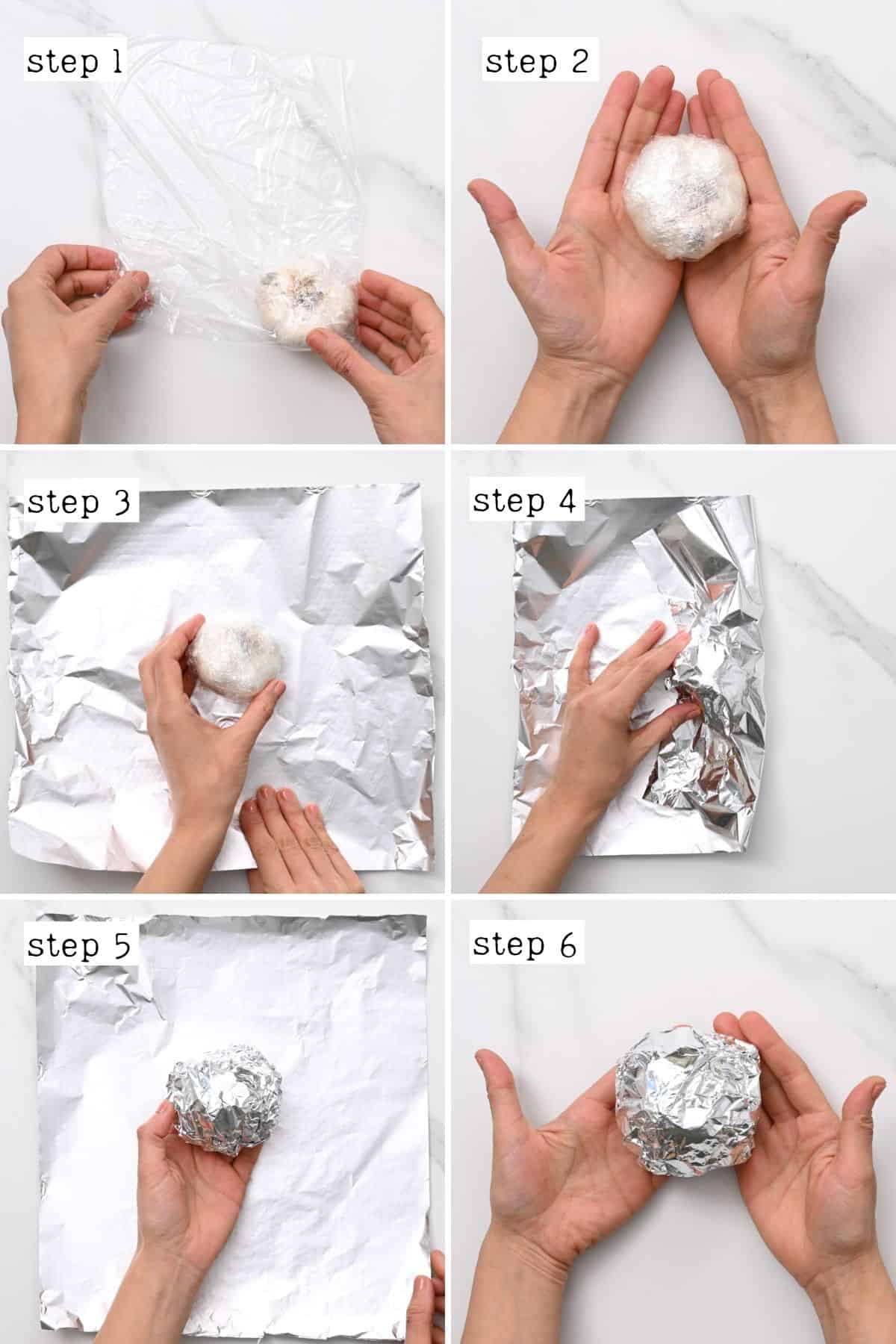This post may contain affiliate links. Please read our disclosure policy.
How to make black garlic – a tender, mellow, slightly sweet, date-like ingredient, perfect for spreading, dipping, and adding to sauces, pasta, soups, etc. Including a long list of FAQs, uses, and top tips!

If you’ve never tried black garlic before, the dark color may look less than appetizing. However, similar to roasted garlic, this aged garlic is mellow and slightly sweet. More so, it’s almost caramel or molasses-like, with a slightly sticky texture. It’s a wonderful addition to all sorts of meals.
Unlike roasted garlic, however, making black garlic, while simple, is also a lengthy process. It takes a minimum of three weeks to achieve the results we’re looking for. Within this post, I’ll take you through what it is, how to make black garlic, as well as several top tips, FAQs, and more information as the ultimate beginner’s guide to black garlic!

Want to save this recipe?
What is black garlic?
First, let’s talk about what it is not. Black garlic is not a naturally growing variety of garlic, as you might think. Instead, it’s a type of aged garlic (also called aged garlic or fermented black garlic) that first appeared in Korea and Thailand.
Controlling the heat and humidity of whole garlic bulbs over several weeks (usually at least 3 up to 12) triggers the “Maillard reaction,” which is the same process that adds flavor to fried onions, seared meat, and toasted marshmallows.

By the end of the process, the raw garlic bulbs are transformed into mild, sweet, slightly molasses/balsamic-like black garlic with a sticky, almost date-like texture and very little smell.
At this stage, the ingredient is not only impressive addition to high-end dishes at many restaurants but it’s also revered as a health product.

What you’ll need
- Garlic: choose fresh garlic with a firm head that feels heavy for its size. Avoid any bulbs that have soft spots, mold, or seem to have dried out. It should be dry and intact.
- Cling film (plastic wrap) and aluminum foil: to wrap the garlic bulbs. Alternatively, you could place them in a large, airtight mason jar (with the lid on).
- Rice cooker/slow cooker OR dehydrator: both can create a temperature-controlled environment for making black garlic.

Several other methods are used to make black garlic, including using a proofer, a specific “black garlic fermenter”, etc. I’ve discussed all of them in the FAQs below.
How to make black garlic
Making black garlic is very simple and hands-off, though it takes several weeks to complete.
Step 1: Prepare the garlic
First, I like to clean the garlic bulbs. Simply use a clean kitchen towel or scrubbing brush to gently remove any dirt. Don’t wet the garlic at all.
Then, wrap the whole bulbs tightly in cling film before adding two layers of aluminum foil.

Alternatively, you may be able to place several garlic bulbs in a single mason jar with the lid on. I haven’t tried this method, but it should work.
Step 2: Leave it to ferment
In a rice cooker/slow cooker: use the keep warm function (not LOW) and place the wrapped garlic bulbs in it for between 3-4 weeks. If your machine auto shuts off, make sure to remember to turn it on again when needed.
Note that once you’ve done this method once, the smell of garlic will linger forever in the appliance.

In a dehydrator: this is my preferred method for complete temperature control using an appliance designed for use over long periods. Set it to 140ºF/60ºC and leave the garlic bulbs to age for 4 weeks.

A proofer: This isn’t a method I’ve tried as I don’t own a proofer. However, it is another option. Not only are proofers perfect for maintaining long periods of low temperatures (used to make bread, yogurt, etc.) and humidity, but they’re also usually cheaper to run.
The process will require a minimum of 3-4 weeks but can be left to age for up to 60 days, depending on the exact results you want. During the process, the garlic will become very hard before it softens and becomes sticky-chewy; this is when they’re ready, though they can be aged even further if preferred.
To test their doneness, press against a clove to feel if it’s soft. It should be slightly sticky/chewy like a date. You could also remove a single clove to test the flavor.
Bonus: How to make black garlic powder
After the garlic has sufficiently aged, peel the papery skin on all the cloves.
Then spread them over a dehydrator rack and dehydrate at 140ºF/60ºC for 24-26 hours until they are light and completely dry.
The exact time will depend on the climate/humidity, size of the cloves, your particular dehydrator. Check at 24 hours and every couple of hours after that until ready.
Transfer the dried cloves to a spice grinder or high-speed blender and process them into a fine powder. Sift it, then reprocess any larger pieces. Then transfer the black garlic powder to a clean, dry, airtight jar.

How to store
Store: store it in an airtight container (unpeeled) for up to 3 months. Ensure it’s completely airtight, so the garlic doesn’t dry out.
Fridge: I prefer to store the garlic bulbs whole in an airtight container/jar and remove and peel cloves as needed. This way, they’ll store for up to 6 months.
Freeze: you can store the entire garlic bulb or separate them into cloves first. I usually leave mine unpeeled. Wrap them tightly with plastic wrap and then store them in the freezer for up to 12 months. It doesn’t freeze solid, so it can be used fairly quickly after removing it from the freezer.
If you fully peel the garlic or make it into a paste, etc., I recommend storing it in an airtight container in the fridge and aiming to use it within a month or 3 to 4 months in the freezer.
Black garlic recipes and uses
- Mash and spread over toast.
- Combine with soy sauce and chili as a simple Asian black garlic stir-fry/ramen sauce.
- Mix it into condiments like mayonnaise or to make a black garlic aioli for spreading over burgers and dipping with fries.
- Mash it into butter, like this roasted garlic butter.
- Mash and combine it with olive oil (or cream cheese/ricotta) to make it black garlic paste. Use it as a spread for toast, bruschetta, crackers, etc.
- Add the black garlic to a cheese platter or charcuterie board.
- Use it within vinaigrettes and salad dressings.
- Mix it into soups (like this roasted cauliflower soup) and curry.
- Add to omelettes.
- Add some to creamy homemade hummus or garlic white bean dip.
- Use it as an umami-rich pizza topper.
- Mash and mix into pasta dishes (like mac n’ cheese or pasta aglio e olio) or slice and serve as a garnish.
- Mash it into creamy black garlic mashed potatoes.
- Dehydrate and grind it into a black garlic powder for an umami boost to tons of meals.
- Use it to create marinades and sauces for meat (like chicken or steak) and fish.
- Thinly slice and use as a salad topper or toast topper (like with avocado toast).

Black garlic works particularly well when it’s the “hero” of a dish, too, rather than just blending into it since it’s so mellow. You can even use black garlic in several desserts such as brownies, choux, ice cream, and more. Let me know in the comments what your favorite black garlic recipes are.
FAQs
Like roasted garlic, black garlic has had the harsh bite of its raw flavor (and smell) reduced. However, the end flavor can vary from batch to batch depending on the sugar content it began with. The higher the sugar, the more caramel-like and mild in flavor. In comparison, low sugar bulbs may be slightly more acidic and sharper while still a lot more mellow than raw garlic.
The flavor is generally described as very muted, subtle, and mellow (meaning more is required in recipes). Some people describe it as a mix of sweet tamarind and balsamic vinegar.
Yes and no. While you can use black garlic in many of the same ways as regular garlic, it isn’t a direct replacement/substitute, and different dishes will make the most of its subtle, slightly sweet flavor without it becoming overpowered by other ingredients.
A recommended daily consumption lies between 1-3 black garlic cloves, but it can vary. There isn’t an exact fixed recommendation.
It is often available at farmer’s markets and farm stores. Alternatively, some Whole Foods markets stock it. You can also often purchase it in whole, peeled, or dehydrated form at specialty stores, like a spice store or health food store. It’s also possible to purchase black garlic online.
It’s technically possible if you use a fermenting box. However, it’s harder to maintain the temperature and humidity, so it isn’t ideal for the aging process.
While it’s often referred to as fermented black garlic, some argue this ingredient isn’t fermented at all. Instead, the changes are attributed to the Maillard reaction (which causes the browning of food when cooked), more closely related to a very low and slow caramelization process rather than fermented. However, there are still arguments that the process also causes fermentation. Unfortunately, I don’t know for sure.
Each method has pros and cons. For example, rice cooker and slow cooker methods are great for not having to purchase any new equipment. However, it can be harder to precisely control their temperature/humidity. Some may run hotter than others, and they can be more expensive to run than some other methods. You’ll also need to leave it running for weeks at a time, which some may be uncomfortable with.
In comparison, a dehydrator or proofer is usually cheaper to run, but they aren’t a typical appliance in many kitchens and are fairly pricey if you don’t already own them.
Lastly, there are specific black garlic fermenter machines. These are fairly economical to run and can cut the process by quite a large margin. However, they were made with a single function in mind and are only really worth buying if you plan to make black garlic frequently.

Top tips and notes
- Choose a well-ventilated area: throughout the entire process of making black garlic, there will be a strong garlic smell, so placing it in a well-ventilated area (i.e., near a window or even in the garage/a shed) is best.
- If you plan to make black garlic often: it may be worth investing in a fermenting box or a specific black garlic fermenter machine.
- Have patience: this isn’t a process to be taken by those with little patience, as it takes several weeks to work. If you check on the garlic and it’s rock hard, cover the lid again and allow it to continue, as it usually needs more time.
- Don’t skip wrapping the bulbs: while I’ve tried it without the plastic wrap/foil layers, I found that the garlic dried out. It’s important to control both the temperature and humidity for this process. I’ve always had the best results when wrapping the bulbs. It also helps with smell!
- Rice cooker/slow cooker temperatures vary: it’s important to use the keep warm setting rather than LOW heat. However, some machines may be too powerful (hot) even then. So make sure to check on the garlic often. Anywhere between 140-176ºF/60-80ºC is usually ideal for making black garlic.
More garlic DIYs
- Garlic and chili infused honey
- Pickled garlic
- Garlic powder
- How to peel garlic
- Homemade garlic paste
- Garlic flakes (dried)
- Lebanese garlic sauce (Toum)
If you try any of the methods or uses for black garlic, I’d love to hear your thoughts/questions below. Also, I’d appreciate a recipe card rating below, and feel free to tag me in your recipe recreations on Instagram @Alphafoodie!

How to Make Black Garlic
Equipment
- Rice cooker – OR –
Ingredients
- 1 head of garlic use as many as you want
Instructions
Step 1: Prepare the Garlic
- Clean the garlic bulbs. Simply use a clean kitchen towel or scrubbing brush to gently remove any dirt. Don't wet the garlic at all.
- Wrap the whole bulbs tightly in cling film before adding two layers of aluminum foil.Alternatively, you may be able to place several garlic bulbs in a single mason jar with the lid on. I haven't tried this method, but it should work.
Step 2: Leave it to Ferment
- In a rice cooker/slow cooker: use the keep warm function (not LOW) and place the wrapped garlic bulbs in it for between 3-4 weeks. If your machine auto shuts off, make sure to remember to turn it on again when needed.Note that once you've done this method once, the smell of garlic will linger forever in the appliance.In a dehydrator: this is my preferred method for complete temperature control using an appliance designed for use over long periods. Set it to 140ºF/60ºC and leave the garlic bulbs to age for 4 weeks.A proofer: this isn't a method I've tried as I don't own a proofer. However, it is another option. Not only are proofers perfect for maintaining long periods of low temperatures (used to make bread, yogurt, etc.) and humidity, but they're also usually cheaper to run.
- The process will require a minimum of 3-4 weeks but can be left to age for up to 60 days, depending on the exact results you want. During the process, the garlic will become very hard before it softens and becomes sticky-chewy; this is when they're ready, though they can be aged even further if preferred. To test their doneness, press against a clove to feel if it's soft. It should be slightly sticky/chewy like a date. You could also remove a single clove to test the flavor.
To Make Black Garlic Powder (Optional)
- After the garlic has sufficiently aged, peel all the cloves.
- Spread them over a dehydrator rack and dehydrate at 140ºF/60ºC for 24-26 hours until they are light and completely dry.The exact time will depend on the climate/humidity, size of the cloves, your particular dehydrator. Check at 24 hours and every couple of hours after that until ready.
- Transfer the dried cloves to a spice grinder or high-speed blender and process them into a fine powder. Sift it, then reprocess any larger pieces. Then transfer the black garlic powder to a clean, dry, airtight jar.
How to Store?
- Store: store it in an airtight container (unpeeled) for up to 3 months. Ensure it's completely airtight, so the garlic doesn't dry out. Fridge: I prefer to store the garlic bulbs whole in an airtight container/jar and remove and peel cloves as needed. This way, they'll store for up to 6 months. Freeze: you can store the entire garlic bulb or separate them into cloves first. I usually leave mine unpeeled. Wrap them tightly with plastic wrap and then store them in the freezer for up to 12 months. It doesn't freeze solid, so it can be used fairly quickly after removing it from the freezer.If you fully peel the garlic or make it into a paste, etc., I recommend storing it in an airtight container in the fridge and aiming to use it within a month or 3-4 months in the freezer.
Notes
- Choose a well-ventilated area: throughout the entire process of making black garlic, there will be a strong garlic smell, so placing it in a well-ventilated area (i.e., near a window or even in the garage/a shed) is best.
- If you plan to make black garlic often: it may be worth investing in a fermenting box or a specific black garlic fermenter machine.
- Have patience: this isn’t a process to be taken by those with little patience, as it takes several weeks to work. If you check on the garlic and it’s rock hard, cover the lid again and allow it to continue, as it usually needs more time.
- Don’t skip wrapping the bulbs: while I’ve tried it without the plastic wrap/foil layers, I found that the garlic dried out. It’s important to control both the temperature and humidity for this process. I’ve always had the best results when wrapping the bulbs. It also helps with smell!
- Rice cooker/Slow cooker temperatures vary: it’s important to use the keep warm setting rather than LOW heat. However, some machines may be too powerful (hot) even then. So make sure to check on the garlic often. Anywhere between 140-176ºF/60-80ºC is usually ideal for making black garlic.
Nutrition
Nutrition information is automatically calculated, so should only be used as an approximation.


















A brilliant and informative piece. I had no idea about black garlic i do now thank you
Hi Sandra, thanks so much for the feedback, glad to hear you found this post useful 🙂
Do you just pull the garlic from your garden and make it into black garlic or do you let it hang to dry for a couple weeks then make it
Hey Marlene! Freshly harvested garlic should be cured (dried) for a few weeks before making black garlic.
Curing allows excess moisture to evaporate, which helps improve flavor and prevents mold during the fermentation process. Ideally, let the garlic hang or spread out in a dry, well-ventilated area for 2-3 weeks until the outer skin is dry and papery. Once cured, it’s ready to be transformed into black garlic!
A very detailed guide on making black garlic! As an active ingredient in some Asian cuisines like Black Garlic Chili Oil Noodles, it definitely does hit the right spots as a foodie!
What isn’t covered in this video though, is the deceptively large bulk of nutrients that black garlic actually gives. They’re clinically known to improve blood sugar control, heart protection, brain health, liver health, increase immunity, and in some cases, even reduce the growth of colon cancer cells!
Hi Stephanie! Thanks for your comment. Black garlic is indeed a versatile ingredient with many health benefits. It’s always important to do your own research when it comes to health supplements. Hope you have a great day
I’ve had my garlic wrapped in cling and tinfoil, in my crock pot for over 5 weeks. It’s dry and flakey. Was the humidity wrong, or do I still wait longer? It’s been dry for 3 weeks already.
Hey Clarissa! If your garlic is dry and flaky after 5 weeks, it’s likely that there wasn’t enough humidity rather than needing more time. Black garlic should turn soft, sticky, and slightly caramelized, not dry.
Wrapping it in cling film and foil can help retain moisture, but if the overall environment inside the crockpot is too dry, it can still dehydrate. Some things that might help next time:
• Try adding a small dish of water inside the crockpot to maintain humidity.
• Make sure the lid is fully closed to trap moisture.
• Check the temperature—it should stay around 60°C (140°F) for the entire process.
Unfortunately, if the garlic has been dry for 3 weeks, it likely won’t recover. If you try again, adjusting the humidity should help!
I’m making black garlic in my dehydrator. We used the canning jar method. We are 4 days in and it looks as if my garlic is sprouting. Is this normal?
Hey Heather! Garlic sprouting during the black garlic process isn’t typical, but it can happen if the humidity or temperature isn’t quite right. Since you’re using the canning jar method in a dehydrator, make sure the temperature is set to around 60°C (140°F) and that there’s some airflow—but not too much.
If the jars are fully sealed, they may trap excess moisture, and if they’re too open, the garlic might dry out too quickly. Try loosely covering the jars with a breathable lid (like cheesecloth or resting a canning lid on top without sealing) to balance airflow and humidity. As long as the garlic is darkening and softening, it should still turn into black garlic over time.
Thank you for a very detailed recipe. I prepared the garlic as instructed and put them in a slow cooker. The warm function is about 68C and cannot be adjusted. The garlic smell was unpleasant during the first 12 hours and after that the occasional smell was not bad at all. Sometimes there was a slightly burn smell. I took one out after 10 days and unwrapped the clove. The garlic had turned black and there were some black ashes. Tasted acidic and dry. Are they done? Thank you.
Hey Wen! It sounds like your garlic may have overcooked due to the temperature being a little high (68°C / 154°F) since black garlic typically develops best around 60°C (140°F) or lower over several weeks.
The black ashes suggest that some cloves dried out too much, which can happen if there wasn’t enough humidity inside the slow cooker. Ideally, black garlic should be soft, sticky, and slightly sweet, not dry or overly acidic.
If the texture isn’t right, it might help to wrap the bulbs in parchment and foil or place a small dish of water in the slow cooker to retain more moisture. If you try again, checking the garlic around 7-8 days instead of 10 might also prevent it from drying out too much. Hope this helps!
I have not heard of using a dehydrator before. It seems that the continuous fan would prevent any moisture which I understood to be part of the process. Can you explain a little more why this works? Thank you.
Hi Karen,
A dehydrator circulates air at very low temperatures and instead of cooking with heat, it draws moisture out of food. This dries out food so they can be stored and enjoyed over a long period of time. I hope this answers your question.
Great recipe- well written with very clear instructions.
Thank you so much for your comment, Chris!
What do you mean wrap the garlic in
Hi Morgen,
The garlic needs to be tightly wrapped in cling film and foil so the humidity and temperature are regulated during the process. Alternatively, you may be able to place several garlic bulbs in a single mason jar with the lid on. I hope this helps.
Can I use the dehydrator outdoors a covered deck? I live in WA state and it’s going to be cold and rainy when I do this.
Hi Judy,
Normally, dehydrators can be used outdoors as long as you have a place to protect the appliance. That said, please make sure to check the manual of your particular brand and follow their recommendations.